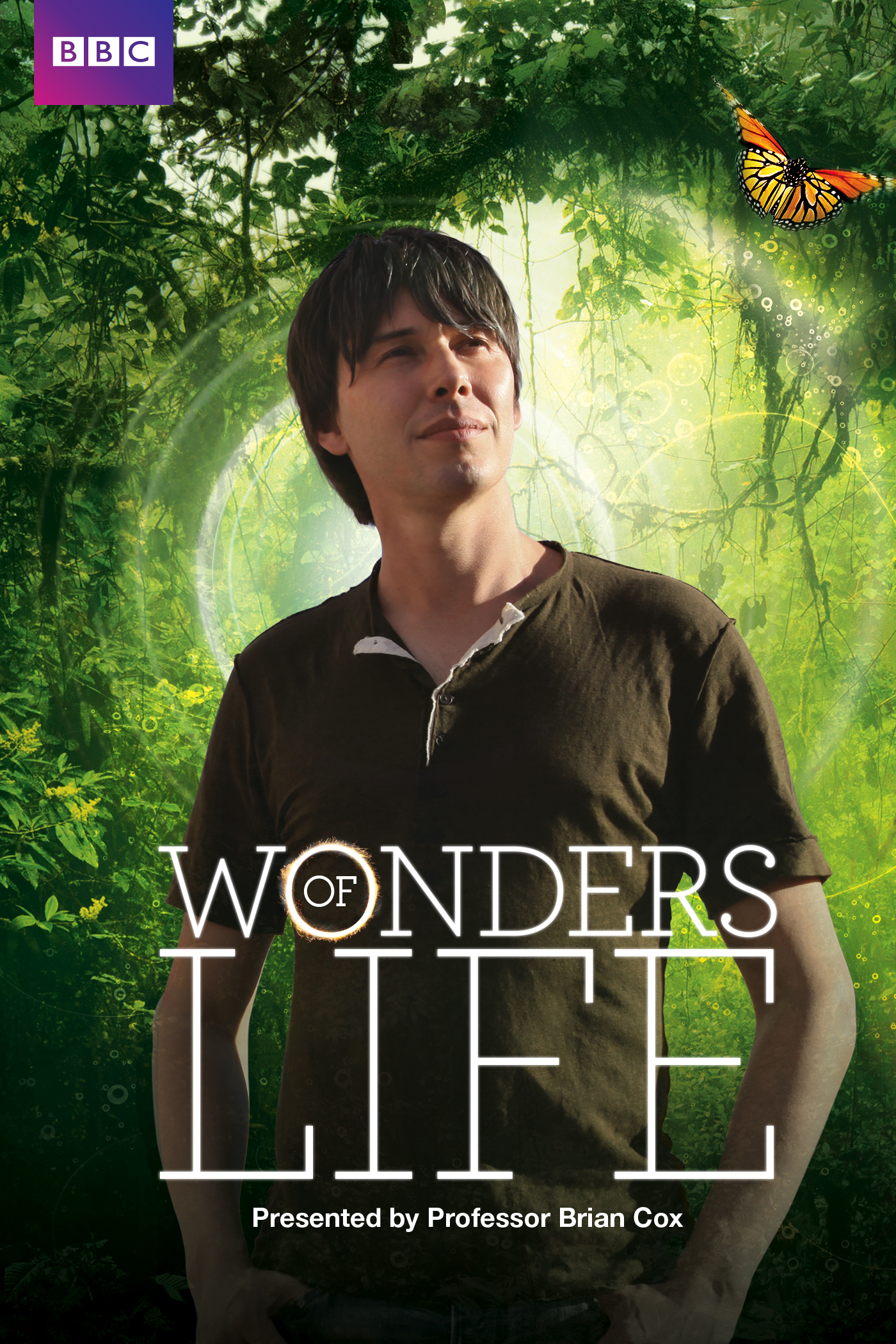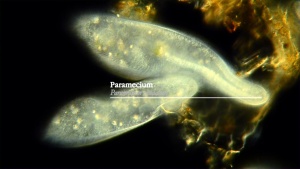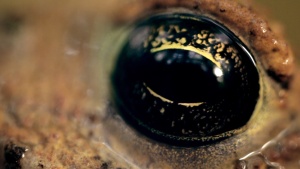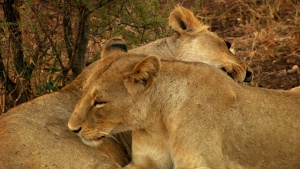This beautiful and definitive series reveals how, 3.7 billion years ago, a few fundamental laws gave birth to the most complex, diverse and unique force in the universe - life. Light, gravity, time, matter and energy are the building blocks of everything, from the smallest microbe on Earth to the biggest galaxy. Today, there are thought to be as many as 100 million different species on Earth. Wonders of Life tells the story of the amazing diversity and adaptability of life through the laws that govern it. From the dance of chromosomes as cells divide to the spark of electricity that causes muscles to move, this series uncovers the secrets of life in the most unexpected locations and in the most stunning detail. Be astonished by the inventiveness of nature and discover the epic journey from the origin of life to our own existence.
Episode 1: What Is Life?
In this episode Brian Cox visits South East Asia's 'Ring of Fire'. In the world's most volcanic region he explores the thin line that separates the living from the dead and poses that most enduring of questions: what is life? The traditional answer is one that invokes the supernatural, as seen at the annual Day of the Dead celebrations in the Philippine highlands. Brian sets out to offer an alternative answer: one bound up in the flow of energy through the universe.
On the edge of Taal Volcano lake, Brian demonstrates how the first spark of life may have arisen. Here, heat energy from the inner Earth forces its way to the surface and changes its chemistry, just as it did in our planet's infancy. It is now believed that these chemical changes set up a source of energy from which life first emerged.
Today, virtually all derives its energy from the Sun. But there's a paradox to this as according to the laws of physics energy can neither be created nor destroyed. So life doesn't 'use' energy up. It can't remove it from the universe. So how does energy enable living things to live?
Brian reveals life to be a conduit through which energy in the universe passes, just one part in a process that governs the lifecycle of the entire Universe. By diverting energy in the cosmos living things are able to grow and thrive.
But whilst the flow of energy can explain living things, it can't explain how life has endured for more than three billion years. So Brian meets an animal in the Borneo rainforest that holds the key to how life persists - the orangutan. Ninety seven per cent of our DNA is shared with orangutans. That shared heritage reveals a profound conclusion: that DNA is a record of the evolution of life on Earth, one that connects us to everything alive today and that has ever lived.
So life isn't really a thing. It's a chemical process, a way of tapping into the energy flowing through the Universe and transmitting it from generation to generation through the elegant chemistry of DNA. Far from demanding a mystical explanation, the emergence of life might be an inevitable consequence of the laws of physics.
Episode 2: Expanding Universe
Amidst the rich natural history of the United States, Professor Brian Cox encounters the astonishing creatures that reveal how the senses evolved.
Every animal on Earth experiences the world in a different way, using a unique suite of senses to detect its physical environment. Tracing the evolution of these mechanisms is a story that takes us through life's journey - from single-celled organisms to more complex, sentient beings. Brian finds that over the course of 3.8 billion years, the senses have driven life in new directions and may, ultimately, have led to our own curiosity and intelligence.
Brian begins deep in the caves of Kentucky, where, devoid of light, he must orientate by sense of touch and sound alone. Yet even in this limited environment he encounters a creature that is perfectly able to find its way around. This is the paramecium, a microscopic single-celled organism.
Despite their apparent simplicity, paramecia display a clear sense of touch, changing direction whenever they bump into something. Brian finds that the electrochemical process through which they 'feel' the world, underlies practically all senses in all living things.
Brian next explores the sense of taste in the muddy waters of the Mississippi Delta. With a metre long catfish in his arms, Brian explains how its entire body is covered in taste buds. These behave like one giant tongue, allowing the catfish to build up a three-dimensional map of its otherwise murky surroundings.
A scuba-dive off the coast of California brings Brian face to face with the strange yet remarkable mantis shrimp. These inhabitants of the ocean floor see the world through eyes made of 10,000 lenses, each with twice as many visual pigments as any other animal on Earth.
But it's in the eyes of the octopus that Brian finds a link between the ability to process sensory data and the emergence of intelligence. This tantalising discovery may be evidence that humans evolved large brains in order to process the vast amounts of information gathered through our sense of vision.
For Brian this raises an extraordinary prospect - that ultimately it was our senses that allowed us to gaze up at the vast expanse of the universe and begin to understand its origins.
Episode 3: Endless Forms Most Beautiful
The universe is almost entirely devoid of life. Earth, the planet we call home, seems to defy the laws of physics. It is teeming with life in all colours, shapes and sizes. No-one knows for sure how many different species are alive right now, our best guess is close to 8.7 million. In this film, Professor Brian Cox asks how, from a lifeless cosmos ruled by the laws of physics and chemistry, it is possible that a planet can produce so much wonderful, varied biology.
It's an epic journey through time that begins with Brian undertaking a species count in the cloud forests of Madagascar. Here, creatures exist that are unique to this isolated Indian Ocean island.
He searches for clues to how species have become so diverse by considering the chemistry of a lion, tracing their molecular connection to the heavens with a visit to the Southern African Large Telescope. Witnessing the ancient formation of stars Brian follows carbon, life's most precious ingredient, as it is captured by the living world. From plants to insects, through grazing herds, all the way up to Africa's big cats, Brian follows carbon as it passes through the food chain.
This leads him to the one carbon rich molecule that controls it all: DNA, the blue print for all living things. On the ancient Karoo plains Brian discovers how once DNA arrived it was inevitably changed. He shows that the universe itself plays an important part in shaping this molecule.
Finally he returns to Madagascar to search for its most famous inhabitants: lemurs. There are over 90 different species across the country, but perhaps one of the most bizarre is known locally as the aye-aye. Being nocturnal and living in some of the densest, most mountainous terrain makes them incredibly difficult to find. Yet Brian is determined to find one because they hold one of the best demonstrations of how DNA is shaped by the environment. For Brian the aye-aye holds the key to understanding why we find ourselves on such a rich, varied and complex living world.
Episode 4: Size Matters
In this episode, Brian travels around Australia to explore the physics of the size of life. Beginning with the largest organisms on our planet, a forest of giant eucalyptus trees, he then takes to the seas to get up-close with an ocean giant - the great white shark. From the safety of a steel cage Brian explains how the distinctive streamlined contours of the great white have been shaped by the physics of water.
Back on land, Brian heads out to the dry dusty outback. Here he tracks the largest living marsupial, the red kangaroo, to see how giants on land adapt to gravity. This all pervasive force influences the way in which living things move and the upper limit on how large they become.
Through the myriad species of insects in Queensland's rainforests, Brian begins his journey into the world of the small. At smaller scales, the effects of gravity are negligible and it is another force - the electrostatic force - that is dominant. This explains how flies and other insects can appear to defy gravity, using the traction of the electrostatic force to scale vertical windows.
But as life gets smaller, the very nature of the world appears to change as Brian explains with the aid of the tiny trichogramma wasp. This is one of the smallest multicellular life forms on Earth. For them, the atmosphere is a highly viscose environment - in a similar way to how we experience liquid - and so the trichogramma has to 'swim' through the air.
Even smaller still, are the thrombolites of Lake Clifton, near Perth. These mysterious growths are made up of colonies of bacteria, the smallest free-living life forms on Earth. Here, Brian finds that the size of life has a lower limit that is governed by the size of atoms and fundamental particles, which in turn are subject to the laws of physics.
The size you are not only dictates which forces of nature affect your life, it also influences your 'speed of life'. The tiny southern bent wing bat of South Australia loses heat so fast that they struggle to find enough food to stay alive. But as life gets larger, the pace of life - or metabolism - slows and this has profound consequences on life expectancy.
Brian explores this idea upon the tropical Christmas Island. This is a land of crabs of all different shapes and sizes. The largest - and most distinctive - are the giant robber crabs whose legs can span a metre. Not only are they the largest land invertebrate, they outlive their smaller cousins, some reaching well over 80 years of age. So the physics of size shapes life in many ways, not least the amount of years you get to enjoy it.
Episode 5: Home
As far as we know, there is only one place in the universe on which life has taken hold - Earth - but for how much longer will this distinction remain? Astronomers are on the brink of finding other worlds the same size as Earth and the same distance from their star. Professor Brian Cox considers what it is about our world that has made it a home and asks what ingredients are necessary to turn a tiny spec of rock in space into a living, vibrant planet.
To find out, Brian has come to one of Earth's richest and most bio-diverse territories, Mexico. He begins by diving in search of our most essential ingredient in a beautiful azure sink hole or cenote, a characteristic feature and primary water source in southern Mexico's Yucatán peninsula. He then travels aboard the spectacular Copper Canyon Railway to measure the impact that the sun has on our planet, discovering how early life had to learn to survive under its glare in ways that still survive in us all today.
At the end of the train journey, he arrives in Mexico's beautiful mountain interior where he uncovers how the relationship life has with the sun has led to one on the most astonishing of all life's inventions: photosynthesis. By turning sunlight into energy, life has tapped a seemingly endless energy source and introduces a vital ingredient to the planet's atmosphere - oxygen.
Finally, Brian visits a remote enclave high up in the pine forests of central Mexico to witness one of nature's greatest sights, the arrival of the monarch butterflies. Each year they make one of the longest migrations of all the butterfly species, over 4000 kilometres from northern Canada to Mexico, by tapping into one the most elusive, intangible and perhaps rarest planetary ingredients of them all.
DISC INFO:
Disc Title: WONDERS_OF_LIFE_D1
Disc Size: 46 185 600 172 bytes
Protection: AACS
BD-Java: No
Extras: 50Hz Content
BDInfo: 0.5.8
PLAYLIST REPORT:
Name: 00015.MPLS
Length: 2:57:51.000 (h:m:s.ms)
Size: 46 003 193 856 bytes
Total Bitrate: 34,49 Mbps
VIDEO:
Codec Bitrate Description
----- ------- -----------
MPEG-4 AVC Video 30990 kbps 1080i / 25 fps / 16:9 / High Profile 4.1
AUDIO:
Codec Language Bitrate Description
----- -------- ------- -----------
DTS-HD Master Audio English 1708 kbps 2.0 / 48 kHz / 1708 kbps / 16-bit (DTS Core: 2.0 / 48 kHz / 1509 kbps / 16-bit / DN -4dB)
SUBTITLES:
Codec Language Bitrate Description
----- -------- ------- -----------
Presentation Graphics English 47,205 kbps
FILES:
Name Time In Length Size Total Bitrate
---- ------- ------ ---- -------------
00064.M2TS 0:00:00.000 0:592.000 15 395 450 880 34 480
00065.M2TS 0:592.000 0:59:13.000 15 313 950 720 34 481
00066.M2TS 1:58:45.000 0:59:06.000 15 293 792 256 34 504
Disc Title: WONDERS_OF_LIFE_D2
Disc Size: 36 509 440 240 bytes
Protection: AACS
BD-Java: No
Extras: 50Hz Content
BDInfo: 0.5.8
PLAYLIST REPORT:
Name: 00015.MPLS
Length: 1:57:22.000 (h:m:s.ms)
Size: 36 328 409 088 bytes
Total Bitrate: 41,27 Mbps
VIDEO:
Codec Bitrate Description
----- ------- -----------
MPEG-4 AVC Video 37496 kbps 1080i / 25 fps / 16:9 / High Profile 4.1
AUDIO:
Codec Language Bitrate Description
----- -------- ------- -----------
DTS-HD Master Audio English 1699 kbps 2.0 / 48 kHz / 1699 kbps / 16-bit (DTS Core: 2.0 / 48 kHz / 1509 kbps / 16-bit / DN -4dB)
SUBTITLES:
Codec Language Bitrate Description
----- -------- ------- -----------
Presentation Graphics English 50,976 kbps
FILES:
Name Time In Length Size Total Bitrate
---- ------- ------ ---- -------------
00064.M2TS 0:00:00.000 0:58:45.000 18 185 828 352 41 273
00065.M2TS 0:58:45.000 0:587.000 18 142 580 736 41 268
Code:http://tenlua.vn/#download1737e526e60d6d01
Results 1 to 1 of 1
Thread: [TENLUA | Documentary | ISO]BBC: Wonders of Life 2-Disc Edition (2013) Blu-ray 1080i AVC DTS-HD 2.0
-
05-12-2014, 08:24 PM #1Thành viên thân thiết Có tí tiếng tăm

- Join Date
- May 2012
- Location
- Usa
- Posts
- 939
- Thanks
- 402
- Thanked
- 418 / 238
[TENLUA | Documentary | ISO]BBC: Wonders of Life 2-Disc Edition (2013) Blu-ray 1080i AVC DTS-HD 2.0
To view links or images in signatures your post count must be 10 or greater. You currently have 0 posts.
-
The Following 2 Users Say Thank You to TrungNT For This Useful Post:
630975 (04-11-2017), dinhtuhuong (05-15-2015)
Thread Information
Users Browsing this Thread
There are currently 1 users browsing this thread. (0 members and 1 guests)
Similar Threads
-
[OTHER] [TENLUA | Documentary | ISO] BBC: Wild Pacific (2009) 2-Disc Edition Blu-ray 1080i AVC DTS-HD 5.1
By TrungNT in forum Phim HDReplies: 0Last Post: 05-12-2014, 07:19 AM -
[OTHER] [TENLUA | Documentary | ISO] BBC: Wild China 2-Disc Edition (2008) Blu-ray 1080i AVC DD2.0
By TrungNT in forum Phim HDReplies: 0Last Post: 05-11-2014, 06:30 PM -
[OTHER] [TENLUA | Documentary | ISO] BBC: Planet Earth Special Edition 6 Disc Set (2006) Blu-ray 1080i VC-1 DTS-HD HR 5.1
By TrungNT in forum Phim HDReplies: 0Last Post: 05-10-2014, 05:55 PM -
[OTHER] [TENLUA | Documentary | ISO | 1 link] BBC: Frozen Planet 3-Disc Edition (2011) BluRay 1080i VC-1 DD2.0
By TrungNT in forum Phim HDReplies: 0Last Post: 05-07-2014, 12:07 PM -
[OTHER] [TENLUA | Documentary | ISO | 1 link] Wildest Arctic (2012) {2-Disc Edition} Blu-ray 1080i AVC DTS-HD 5.1
By TrungNT in forum Phim HDReplies: 0Last Post: 05-06-2014, 09:46 PM






































 Reply With Quote
Reply With Quote